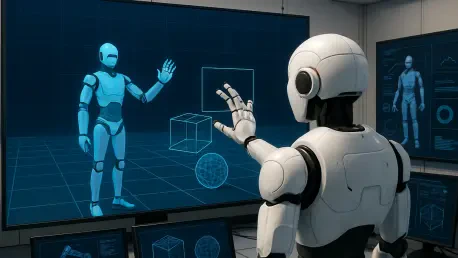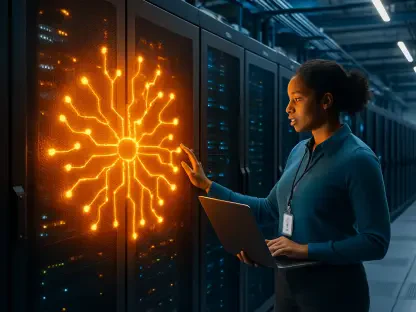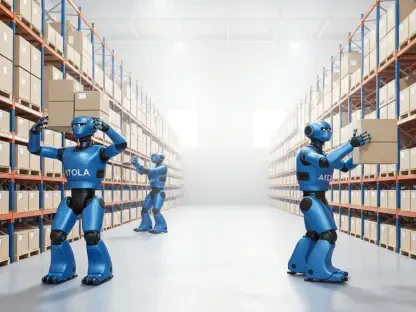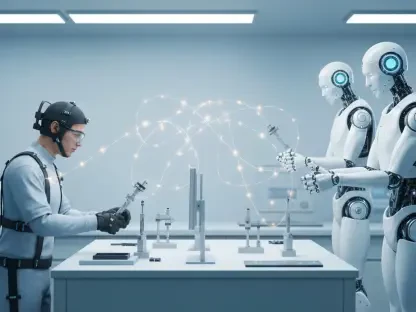Imagine a world where robots can seamlessly adapt to any task, no matter how unexpected or unfamiliar, without faltering or requiring extensive retraining. This isn’t a distant dream but a rapidly approaching reality, driven by groundbreaking advancements in virtual task training for robotics. In dynamic environments—think autonomous vehicles navigating chaotic urban streets or drones responding to sudden weather shifts—adaptability is the key to success. Yet, traditional training methods often leave robots rigid and unprepared for the unpredictable. This review dives into the transformative potential of virtual task training, spotlighting an innovative approach that equips robots with the flexibility to tackle unforeseen challenges through simulated experiences.
Core Principles and Emergence of Virtual Task Training
Virtual task training marks a significant shift in how robots learn and adapt, moving beyond the constraints of conventional reinforcement learning. At its heart, this technology leverages simulated environments to create self-generated experiences, allowing robots to prepare for tasks they’ve never encountered in the real world. This approach emerged as a response to the glaring limitations of traditional methods, where robots trained for specific scenarios often fail when faced with out-of-distribution challenges—situations outside their training data.
The relevance of this technology cannot be overstated in today’s fast-evolving industries. As robots are increasingly deployed in unpredictable settings, from industrial warehouses to emergency response zones, the ability to handle novel tasks without human intervention becomes critical. Virtual task training offers a pathway to achieve this by enabling machines to anticipate and practice responses in a risk-free digital space before applying them in reality.
This paradigm shift is particularly vital for applications where safety and precision are paramount. By simulating complex, dynamic conditions, robots can develop a level of adaptability that mirrors human intuition, adjusting behaviors on the fly. The focus now turns to understanding the mechanisms that make this possible, revealing how cutting-edge frameworks are reshaping robotic capabilities.
Inside the Task-Aware Virtual Training (TAVT) Framework
Central to the evolution of virtual task training is the Task-Aware Virtual Training (TAVT) framework, a meta-reinforcement learning technique designed to enhance robotic flexibility. Developed by leading researchers, TAVT operates through a dual-module system that sets it apart from earlier methods. The first module, a representation component, analyzes task similarities by mapping features into a latent space, enabling the system to understand relationships between different scenarios.
The second module focuses on generation, creating virtual scenarios that mimic real-world challenges. This synthesis of tasks allows robots to “pre-experience” conditions they haven’t faced, preparing them for unexpected situations with remarkable accuracy. The significance of TAVT lies in its proactive approach, equipping robots to handle complexities without relying on exhaustive real-world training data.
Performance outcomes from TAVT are striking, particularly in controlled simulations. Robots trained under this framework demonstrate superior adaptability, maintaining stability and efficiency when confronted with novel tasks. This capability positions TAVT as a cornerstone for future robotic systems, promising to bridge the gap between rigid programming and true autonomy in diverse operational contexts.
Self-Generated Virtual Experiences: A Deeper Look
A defining feature of virtual task training is the concept of self-generated virtual experiences, where robots simulate and practice tasks independently. Through advanced algorithms, these systems craft detailed scenarios that replicate potential real-world conditions, enabling machines to test responses and refine strategies without physical risk. This process fundamentally enhances generalization, allowing robots to apply learned behaviors to entirely new situations.
In practical terms, self-generated experiences have shown measurable improvements in robotic performance. For instance, in simulated environments, robots using this method have adapted to variables like speed or terrain changes that were absent from their initial training. Such outcomes highlight the technology’s role in pushing boundaries, ensuring robots are not just reactive but anticipatory in their actions.
The technical underpinnings of this approach involve complex deep learning models that continuously evolve as more scenarios are simulated. By iterating through countless virtual tasks, robots build a repository of responses that can be drawn upon instantly when needed. This innovation marks a leap toward creating machines that learn with a depth and flexibility previously thought unattainable.
Recent Breakthroughs and Industry Trends
The field of virtual task training is witnessing rapid advancements, with TAVT standing as a prime example of current innovation. Research teams have refined meta-reinforcement learning to prioritize proactive adaptation, focusing on how robots can independently prepare for the unknown. This trend reflects a broader industry push toward systems that thrive in real-world unpredictability, moving away from static, controlled training environments.
Emerging tools and methodologies are further accelerating progress. Enhanced simulation platforms now integrate more realistic physics and environmental factors, offering robots a richer training ground. These developments are complemented by a growing emphasis on computational efficiency, ensuring that even resource-intensive virtual training remains viable for widespread adoption.
Collaboration across academia and industry is also fueling momentum. As researchers share insights and refine frameworks like TAVT, the technology inches closer to practical deployment. Looking ahead, the integration of virtual training with other AI domains, such as natural language processing for human-robot interaction, could unlock even greater potential, reshaping how robots operate in complex settings.
Real-World Impact and Application Areas
Virtual task training is already making waves across multiple sectors, demonstrating tangible benefits in real-world applications. In autonomous vehicles, for example, robots trained through virtual simulations can better navigate unexpected road conditions, adjusting to variables like sudden obstacles or erratic traffic patterns. This adaptability is crucial for ensuring safety and reliability in high-stakes environments.
Drones represent another key area of impact, where virtual training enables rapid responses to dynamic challenges such as wind shifts or equipment malfunctions. Research simulations, like the Cheetah-Vel-OOD test conducted in MuJoCo environments, illustrate this vividly—robots adapted to intermediate speeds they weren’t explicitly trained for, maintaining balance and performance far better than those under traditional methods.
Robotic assistance in healthcare and industrial settings also stands to gain. From surgical robots adjusting to unique patient anatomies to warehouse bots handling unforeseen inventory layouts, the technology’s ability to foster quick adaptation promises efficiency and precision. These examples underscore the transformative power of virtual training, paving the way for broader implementation across diverse fields.
Challenges Hindering Broader Adoption
Despite its promise, virtual task training faces significant hurdles that must be addressed for mainstream integration. One primary challenge is scaling simulations to match the complexity of real-world environments. While controlled digital scenarios show success, replicating the full spectrum of variables—such as human behavior or environmental anomalies—remains technically daunting.
Computational constraints pose another barrier. Generating and processing vast arrays of virtual tasks demands substantial resources, potentially limiting accessibility for smaller organizations or applications with tight budgets. Balancing accuracy with efficiency is an ongoing struggle, requiring innovative solutions to optimize performance without sacrificing quality.
Validation across diverse scenarios also presents difficulties. Ensuring that virtual training translates reliably to varied real-world contexts demands rigorous testing and refinement. Current efforts focus on expanding simulation diversity and developing robust benchmarking standards, but these challenges highlight the need for sustained investment and research to fully realize the technology’s potential.
Looking Ahead: The Future of Robotic Training
The trajectory of virtual task training points toward exciting possibilities, with potential breakthroughs on the horizon. Integration with complementary AI technologies, such as advanced vision systems or predictive analytics, could further enhance robotic adaptability, creating systems that not only react but also anticipate with near-human foresight. This synergy promises to redefine autonomy in critical sectors like transportation and emergency response.
Over the next few years, from 2025 to 2027, expect significant strides in simulation realism and computational efficiency. Researchers are already exploring ways to leverage cloud-based processing to offload training demands, potentially democratizing access to this technology. Such advancements could accelerate deployment in resource-constrained environments, broadening its reach.
Long-term, the impact of virtual task training may reshape entire industries. As robots become more capable of navigating unpredictable settings, their role in healthcare, logistics, and beyond will expand, driving innovation and efficiency. The focus remains on overcoming existing barriers, ensuring that this technology evolves into a cornerstone of next-generation robotic systems.
Final Reflections and Next Steps
Reflecting on the journey of virtual task training, it is evident that frameworks like TAVT have redefined what robots can achieve, pushing the boundaries of adaptability through self-generated simulations. The technology has proven its worth in controlled tests, showcasing remarkable flexibility in handling unforeseen tasks, from speed adjustments in robotic cheetahs to nuanced responses in dynamic scenarios.
Moving forward, the priority should be on collaborative efforts to address scalability and resource challenges, ensuring that virtual training becomes accessible to a wider array of applications. Industry leaders and researchers must invest in creating standardized validation protocols to guarantee real-world reliability, while exploring partnerships to integrate this technology with other AI innovations.
Ultimately, the path ahead involves not just refining the tools but also reimagining their deployment—tailoring solutions to specific industry needs and fostering an ecosystem where robots continuously learn and evolve. By focusing on these actionable steps, the robotic landscape is poised for a transformation, with virtual task training at the helm of this exciting shift.









